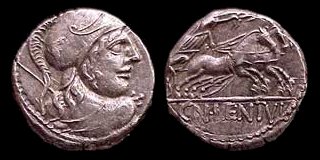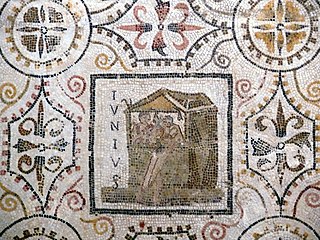
The Circus Maximus is an ancient Roman chariot-racing stadium and mass entertainment venue in Rome, Italy. In the valley between the Aventine and Palatine hills, it was the first and largest stadium in ancient Rome and its later Empire. It measured 621 m (2,037 ft) in length and 118 m (387 ft) in width and could accommodate over 150,000 spectators. In its fully developed form, it became the model for circuses throughout the Roman Empire. The site is now a public park.

In ancient Roman religion, Ceres was a goddess of agriculture, grain crops, fertility and motherly relationships. She was originally the central deity in Rome's so-called plebeian or Aventine Triad, then was paired with her daughter Proserpina in what Romans described as "the Greek rites of Ceres". Her seven-day April festival of Cerealia included the popular Ludi Ceriales. She was also honoured in the May lustration (lustratio) of the fields at the Ambarvalia festival: at harvest-time: and during Roman marriages and funeral rites. She is usually depicted as a mature woman.

In ancient Roman religion and mythology, Liber, also known as Liber Pater, was a god of viticulture and wine, male fertility and freedom. He was a patron deity of Rome's plebeians and was part of their Aventine Triad. His festival of Liberalia became associated with free speech and the rights attached to coming of age. His cult and functions were increasingly associated with Romanised forms of the Greek Dionysus/Bacchus, whose mythology he came to share.
In ancient Roman religion, Strenua or Strenia was a goddess of the new year, purification, and wellbeing. She had a shrine (sacellum) and grove (lucus) at the top of the Via Sacra. Varro said she was a Sabine goddess. W.H. Roscher includes her among the indigitamenta, the lists of Roman deities maintained by priests to assure that the correct divinity was invoked in public rituals. The procession of the Argei began at her shrine.
In ancient Roman religion, Tempestas is a goddess of storms or sudden weather. As with certain other nature and weather deities, the plural form Tempestates is common. Cicero, in discussing whether natural phenomena such as rainbows and clouds should be regarded as divine, notes that the Tempestates had been consecrated as deities by the Roman people.

In ancient Roman religion, the Cerealia was the major festival celebrated for the grain goddess Ceres. It was held for seven days from mid- to late April. Various agricultural festivals were held in the "last half of April". The Cerealia celebrated the harvest, and may have begun on the 19th. Surviving descriptions of Rome's city festival of Ceres are presumably urban versions of an originally rustic, agricultural festival. In his treatise on agriculture, Cato the Elder recommends that farmers sacrifice a sow to Ceres, before the harvest.
Festivals in ancient Rome were a very important part in Roman religious life during both the Republican and Imperial eras, and one of the primary features of the Roman calendar. Feriae were either public (publicae) or private (privatae). State holidays were celebrated by the Roman people and received public funding. Games (ludi), such as the Ludi Apollinares, were not technically feriae, but the days on which they were celebrated were dies festi, holidays in the modern sense of days off work. Although feriae were paid for by the state, ludi were often funded by wealthy individuals. Feriae privatae were holidays celebrated in honor of private individuals or by families. This article deals only with public holidays, including rites celebrated by the state priests of Rome at temples, as well as celebrations by neighborhoods, families, and friends held simultaneously throughout Rome.
The Robigalia was a festival in ancient Roman religion held April 25, named for the god Robigus. Its main ritual was a dog sacrifice to protect grain fields from disease. Games (ludi) in the form of "major and minor" races were held. The Robigalia was one of several agricultural festivals in April to celebrate and vitalize the growing season, but the darker sacrificial elements of these occasions are also fraught with anxiety about crop failure and the dependence on divine favor to avert it.

In Roman religion, Terminus was the god who protected boundary markers; his name was the Latin word for such a marker. Sacrifices were performed to sanctify each boundary stone, and landowners celebrated a festival called the "Terminalia" in Terminus' honor each year on February 23. The Temple of Jupiter Optimus Maximus on the Capitoline Hill was thought to have been built over a shrine to Terminus, and he was occasionally identified as an aspect of Jupiter under the name "Jupiter Terminalis".

Juno was an ancient Roman goddess, the protector and special counsellor of the state. She was equated to Hera, queen of the gods in Greek mythology and a goddess of love and marriage. A daughter of Saturn and Ops, she was the sister and wife of Jupiter and the mother of Mars, Vulcan, Bellona, Lucina and Juventas. Like Hera, her sacred animal was the peacock. Her Etruscan counterpart was Uni, and she was said to also watch over the women of Rome. As the patron goddess of Rome and the Roman Empire, Juno was called Regina ("Queen") and was a member of the Capitoline Triad, centered on the Capitoline Hill in Rome, and also including Jupiter, and Minerva, goddess of wisdom.

In ancient Roman religion and mythology, Tellus Mater or Terra Mater is the personification of the Earth. Although Tellus and Terra are hardly distinguishable during the Imperial era, Tellus was the name of the original earth goddess in the religious practices of the Republic or earlier. The scholar Varro (1st century BC) lists Tellus as one of the di selecti, the twenty principal gods of Rome, and one of the twelve agricultural deities. She is regularly associated with Ceres in rituals pertaining to the earth and agricultural fertility.

The Equirria were two ancient Roman festivals of chariot racing, or perhaps horseback racing, held in honor of the god Mars, one 27 February and the other 14 March.

Ludi were public games held for the benefit and entertainment of the Roman people . Ludi were held in conjunction with, or sometimes as the major feature of, Roman religious festivals, and were also presented as part of the cult of state.
In ancient Roman religion, the Fordicidia was a festival of fertility, held on the Ides of April, that pertained to farming and animal husbandry. It involved the sacrifice of a pregnant cow to Tellus, the ancient Roman goddess of the Earth, in proximity to the festival of Ceres (Cerealia) on April 19.
The Aventine Triad is a modern term for the joint cult of the Roman deities Ceres, Liber and Libera. The cult was established c. 493 BC within a sacred district (templum) on or near the Aventine Hill, traditionally associated with the Roman plebs. Later accounts describe the temple building and rites as "Greek" in style. Some modern historians describe the Aventine Triad as a plebeian parallel and self-conscious antithesis to the Archaic Triad of Jupiter, Mars and Quirinus and the later Capitoline Triad of Jupiter, Minerva and Juno. The Aventine Triad, temple and associated ludi served as a focus of plebeian identity, sometimes in opposition to Rome's original ruling elite, the patricians.
The Vitulatio was an annual thanksgiving celebrated in ancient Rome on July 8, the day after the Nonae Caprotinae and following the Poplifugia on July 5. The Poplifugia is a lesser-known festival that was of obscure origin even for the Romans themselves; Macrobius says that it marked a Roman retreat from the Etruscans at Fidenae during the Gallic invasion, and that the Vitulatio commemorated their comeback victory. It was a dies religiosus, a day of religious prohibition when people were to refrain from undertaking any activity other than attending to basic necessities.

Aprilis or mensis Aprilis (April) was the fourth month of the ancient Roman calendar in the classical period, following Martius (March) and preceding Maius (May). On the oldest Roman calendar that had begun with March, Aprilis had been the second of ten months in the year. April had 29 days on calendars of the Roman Republic, with a day added to the month during the reform in the mid-40s BC that produced the Julian calendar.

Mensis Iunius or Iunius, also Junius (June), was the sixth month of the Roman calendar of the classical period, following Maius (May). In the oldest calendar attributed by the Romans to Romulus, Iunius had been the fourth month in a ten-month year that began with March (Martius, "Mars' month"). The month following June was thus called Quinctilis or Quintilis, the "fifth" month. Iunius had 29 days until a day was added during the Julian reform of the calendar in the mid-40s BC. The month that followed Iunius was renamed Iulius (July) in honour of Julius Caesar.

Venus Verticordia was an aspect of the Roman goddess Venus conceived as having the power to convert either virgins or sexually active women from dissolute desire (libido) to sexual virtue (pudicitia). Under this title, Venus was especially cultivated by married women, and on 1 April she was celebrated at the Veneralia festival with public bathing.
Venus Obsequens was the first Venus for whom a shrine (aedes) was built in ancient Rome. Little is known of her cult beyond the circumstances of her temple founding and a likely connection to the Vinalia Rustica, an August wine festival.












